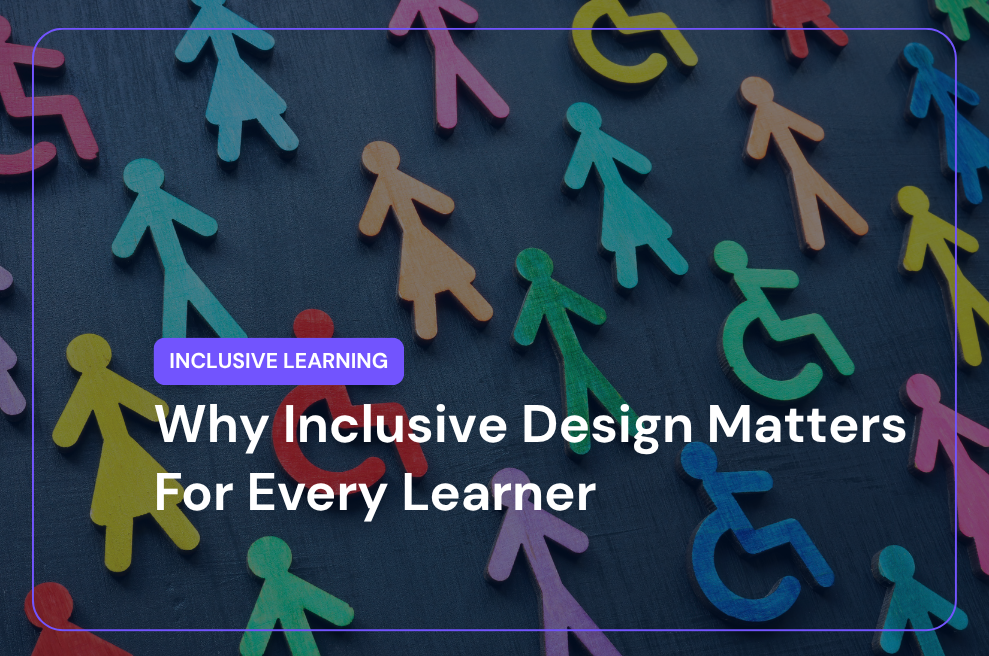Imagine starting an online course eager to learn, but find the content difficult to navigate, videos lack captions, and assessments rely solely on a single-timed test that doesn’t reflect your strength. Frustrating, right? For many learners, this is a daily reality.
Research shows that the number of students with disabilities attending institutions of higher learning is growing, and these numbers might even be understated because “students with disabilities, like their peers, typically develop their independence and build their identities during college” and therefore, “want to avoid pity, embarrassment, and stigma by disclosing personal information.” (Lomellini et al., 2025).
This makes accessible learning design an increasingly important consideration in course development.
Effective learning design isn’t just about delivering content. It’s about shaping how learners engage with, process, and apply knowledge. As the educational landscape continues to grow and evolve, it is imperative that we intentionally design learning experiences that support all learners. A research-driven approach rooted in Universal Design for Learning (UDL) and accessibility best practices can ensure that learning is not only accessible but also equitable, empowering, and impactful. This framework, developed by CAST, helps create flexible learning environments that are adaptable to different learners’ needs.
The Foundations of Inclusive Learning Design
To support diverse online learners, instructional design must move beyond compliance checklists. It needs to actively embrace and develop inclusive, flexible, and personalized learning experiences. Grounded in UDL, this approach ensures learning environments adapt to varied abilities, learning preferences, and backgrounds, fostering a more equitable learning experience.
Core Principles of UDL
UDL was built on advances in neuroscience and technology, and is based on three core principles:
Multiple Means of Engagement
Not all learners are motivated by the same experiences. Inclusive learning design provides varied ways to engage with content to foster motivation, persistence, and a sense of belonging. A 2010 case study by Marie E. Leichliter, from a leading university in West Virginia found that implementing various engagement strategies led to positive student reception and increased engagement.
The following are practical applications:
- Choice and autonomy: Provide learners with options to select topics, explore alternative pathways, or choose assessment formats that align with their strengths.
- Culturally responsive content: Design materials that reflect diverse perspectives, voices, and real-world applications.
- Interactive and collaborative learning: Encourage social learning through peer discussions, group projects, and interactive exercises.
Multiple Means of Representation
Learners perceive, process, and retain information differently, making it important to provide content in multiple formats. This improves understanding and makes learning more accessible for the learner.
Some practical applications:
- Accessible multimedia: Provide transcripts, captions, and audio descriptions for videos.
- Alternative formats: Provide text-based, audio, and visual materials to accommodate different learning styles.
- Assistive technology integration: Ensure compatibility with screen readers, text-to-speech tools, and alternative navigation options.
At Construct Education, we recently implemented a comprehensive corporate training program that features multilingual subtitles and AI-driven real-time transcripts. According to client feedback, this initiative has proven to be a game-changer, and has led to increased course completion rates among non-native English speakers.
Multiple Means of Action and Expression
Traditional assessments, such as timed exams or essays, can pose barriers for many learners. Inclusive learning design allows for flexibility in how learners demonstrate understanding, allowing them to showcase their knowledge in ways that work best for them.
Useful applications include:
- Flexible assessment options: Enable learners to submit work in text, video, or interactive formats.
- Scaffolded learning paths: Allow learners to progress at their own pace while receiving meaningful feedback.
- Executive function support: Integrate tools such as AI-assisted coaching, guided templates, checklists, and structured discussions to aid planning and organization.
Beyond Compliance: Accessibility as a Competitive Advantage
Accessibility is often seen as a compliance requirement, but if you proactively design for inclusivity, you will gain a significant competitive edge.
Courses that prioritize accessibility:
- Expand their audience reach by removing barriers for all learners, including those impacted by disabilities, language differences, and diverse cognitive needs.
- Improve learner engagement and retention by ensuring all participants can fully interact with the material.
- Reduce the need for retroactive accessibility fixes, saving time and resources.
- Strengthen brand reputation by positioning organizations as leaders in equitable education and corporate training.
Take the Next Step Towards Inclusive Learning
The future of education and corporate training lies in learning experiences that meet the needs of all individuals, regardless of ability, background, or learning style. UDL principles and accessibility best practices enable you to create flexible, effective, equitable, and future-proof online learning experiences for all learners.
Ready to make your courses more inclusive? Start by evaluating your current learning materials. Where can you integrate more choice, multimodal content, or flexible assessments?
At Construct, we go beyond compliance. We design learning solutions grounded in a research-driven approach to create equitable, transformative, and meaningful online learning experiences for diverse learners.
We aim for AA-level compliance with the Web Content Accessibility Guidelines 2.2 (WCAG 2.2) ensuring that every learner has the opportunity to succeed. Join us in building a more inclusive future for education and corporate training.

